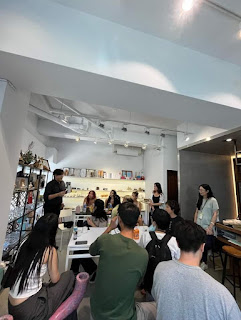Two
On Wednesday we Visited Dot Design. A design studio that finds creative uses for materials that would otherwise go to waste. Their "re-ing" product line makes products from discarded playground toys, pineapple leaves, bamboo, milk cartons, and more. The discarded playground toys were melted down and molded into chairs. Their color kind of looked like rainbow confetti, because all of the plastics were mixed together. I think that they would have looked better and would be easier to sell if they were single colors, but the nature of the mixed recycling would make that very hard. I was particularly interested in the pineapple leaves because they are an immediate byproduct of the pineapple farming industry. I think that may be the issue of by-products can be addressed differently from discarded products. I think the pineapple leaf situation allows for a consistent and convenient flow of materials, and it doesn't face the same challenges as the confetti chairs, because the leaves are directly from the source, and haven't been mixed with other trash.
I think that this byproduct repurposing is a sustainability process that has a lot of potential for expansion. Byproduct repurposing is an interaction where two parties are involved: the party who produces byproducts and the party who repurposes them. For wider adoption to take place I think we need to incentivize the practice by adding value for both parties. My idea for adding value would be to use the government as a lever. There could be a government committee which issues credits based on the percentage of their manufacturing waste that is contacted to be repurposed. Maybe these credits can be redeemed in exchange for temporary advertising space in public transit facilities. The public transit facilities are already owned by the government and the space is very valuable because there is so much foot traffic in those areas. In this case the waste repurposing party will have the ability to provide a more valuable service to the waste producing party. I think this value is something that the waste producing party would be willing to pay for. If the repurposing party could charge money to collect materials, I think they would have a great edge over their less sustainable competitors. This would shake up the economy in a serious way, but a shake up is what we need if we want to change course.
In the long term, widespread adoption of byproduct repurposing could lead to significant environmental, economic, and societal benefits. Environmentally, this practice would help reduce waste sent to landfills and decrease the demand for virgin materials, thereby lowering the carbon footprint of manufacturing industries. Economically, it could create new markets and job opportunities in recycling and repurposing sectors, fostering innovation and competition among businesses to find efficient ways to utilize byproducts. Additionally, by encouraging collaboration between manufacturers and repurposers, industries could experience cost savings, as waste becomes a resource rather than a disposal expense.Socially, the increased focus on sustainability could drive consumer awareness and demand for eco-friendly products, leading to a cultural shift toward more responsible consumption. This systemic change, supported by governmental incentives, could pave the way for a circular economy, where waste is minimized, and resources are reused, benefiting both the planet and future generations.




Comments
Post a Comment